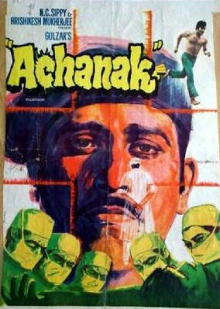Achanak (1973 film)
| Achanak | |
|---|---|
 Achanak film poster | |
| Directed by | Gulzar |
| Written by | Khwaja Ahmad Abbas Gulzar |
| Produced by | Raj N. Sippy Romu N. Sippy |
| Starring | Vinod Khanna Lily Chakravarty Asrani |
| Cinematography | K. Vaikunth |
| Edited by | Waman B. Bhosle Gurudutt Shirali |
| Music by | Vasant Desai |
Release date |
|
| Country | India |
| Language | Hindi |
Achanak (transl. Suddenly) is a 1973 Indian Hindi-language film, directed by Gulzar, written by Khwaja Ahmad Abbas, and starring Vinod Khanna. Gulzar received a Filmfare nomination as Best Director for this film. Even though Gulzar is an accomplished lyricist, this film did not have any songs in it.[1] K.A. Abbas earned a Filmfare nomination for best story.[2] It is inspired by the real-life sensational 1958 murder case KM Nanavati v State of Maharashtra.[3]
The actual messages conveyed by the movie are more sublime than simple cuckoldry. First and foremost is the futility of a doctor's efforts to save life of an already condemned person. Tragically, the doctor saves the life of a person, who is already condemned. After months of untiring efforts of doctors, nurses and all paramedical staff, the condemned person finally meets his fate at the gallows. Ethics of human killing is another message. While on one hand the protagonist is awarded a Vir Chakra for killing several humans, on another he is punished to death for killing just two humans.
1963 movie Yeh Rastey Hain Pyar Ke was also based on the same case.[4] Akshay Kumar starrer 2016 movie Rustom is based on the same case as well.[5]
The film had no songs, the background score is composed by Vasant Desai.
Plot
[edit]Major Ranjit Khanna loves his wife Pushpa, who loves him equally. His commanding officer, Lt. Col. Bakshi, is his father-in-law. Ranjit is happy in his married life, until he finds out about his wife's affair with his best friend. On realizing this, however, he kills both of them and surrenders himself to the police. Then, he escapes from the police in search of the river Ganga, as he wants to fulfill his wife's desire to leave her Mangalsutra in the river Ganga. However, in that attempt, the police shoot him and he is injured. He is then admitted to the hospital, where he becomes emotionally attached to the doctors and nurses. So, when he is finally sentenced to death, they also move to tears.
Cast
[edit]| Character | Actor |
|---|---|
| EX -Major Ranjeet Khanna | Vinod Khanna |
| Dr Chaudhary | Om Shivpuri |
| Mrs Pushpa Khanna | Lily Chakravarty |
| Nurse Radha | Farida Jalal |
| Dr Kailash | Asrani |
| Colonel Bakshi | Iftekhar |
| Mr Gupta, Supdt of Police | Kamal Deep |
Production
[edit]The entire film production was completed in 28 days.[6] Achanak was based on a Khwaja Ahmed Abbas story, The Thirteenth Victim, which had appeared in the magazine called Imprint.[7] In 1973 N.C Sippy's sons, Romu Sippy and Raj Sippy collaborated with partner Hrishikesh Mukherjee to produce Achanak and they approached Gulzar to direct it. Gulzar approached Vasantrao, a marathi background score composer to compose the score for this film since it would have no songs otherwise.[1]
Soundtrack
[edit]Background music was composed by Vasant Desai.
| # | Song Title | Singer |
|---|---|---|
| 1 | "Sun Mere Bandhu Re" | S D Burman |
References
[edit]- ^ a b Gavankar, Nilu N. (2011). The Desai trio and the movie industry of India. Bloomington, IN: AuthorHouse. p. 236. ISBN 978-1-4634-1941-7.
- ^ "1st Filmfare Awards 1953" (PDF). Archived from the original (PDF) on 12 June 2009. Retrieved 25 July 2010.
- ^ "Inspired by Nanavati". Hindustan Times. 19 December 2002. Archived from the original on 18 October 2012. Retrieved 18 July 2022.
- ^ Parsai, Gargi (12 August 2010). "Yeh Rastey Hain Pyar Ke (1963)" – via www.thehindu.com.
- ^ "Gulzar's Achanak is what Akshay Kumar's Rustom would have been if it didn't take the easy way out". 21 January 2023.
- ^ Chatterjee, Saibal: "Echoes & Eloquences: The Life and Cinema of Gulzar", page 95. Rupa & Co, 2007. ISBN 978-81-291-1235-4
- ^ Chatterjee, Saibal: "Echoes & Eloquences: The Life and Cinema of Gulzar", page 93. Rupa & Co, 2007. ISBN 978-81-291-1235-4
External links
[edit]
- 1973 films
- 1970s Hindi-language films
- 1970s Indian films
- Films directed by Gulzar
- Films with screenplays by Khwaja Ahmad Abbas
- Indian romantic drama films
- Indian films based on actual events
- Hindi-language films based on actual events
- Indian legal drama films
- Films about juries
- Films about adultery in India
- 1970s Hindi-language film stubs
